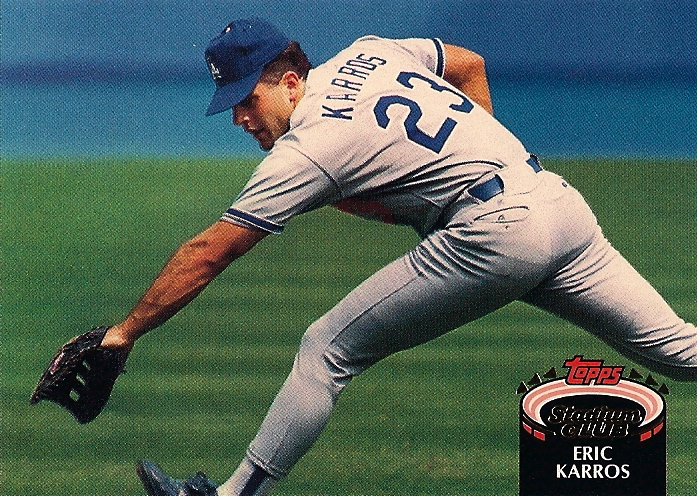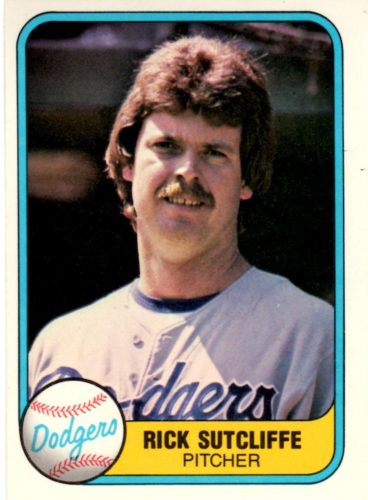We are clearly struggling for content here if I am making up simulated sign-stealing scandals and finding an excuse to write about Joe Thurston. But here’s something that might be more interesting than those time wasters, a look at all 14 of the Los Angeles Dodgers’ NL Rookie of the Year winners. I’m going to skip Brooklyn in this, though I may eventually revisit those seasons as well depending on how long this baseball freeze lasts.
While the franchise has 18 Rookie of the Year awards between the two cities, Los Angeles’ 14 still tops the next closest franchise, which is of course the New York Yankees (9). Clearly it is an unfair comparison given how long the franchises have existed, but Los Angeles also has more than the Giants (6), Padres (2) Rockies (1) and Diamondbacks (0) have combined.
Anyway, I’m going to rank these based on how impressive the seasons were, as well as how deserving they truly were of the award, though I am well aware the different decades looked at stats differently than they do in the present. Unsurprisingly, some of these stand out much more than others.
14. Ted Sizemore, 1969
.271/.328/.342/.670, .071 ISO, 4 HRs, 46 RBIs, 6.2 K%, 95 wRC+, 2.8 WAR
Maybe it is just an indictment of the offense of the generation, but Sizemore’s numbers are a bit shocking for a Rookie of the Year.
Coming a season after the “Year of the Pitcher,” Sizemore earned the starting shortstop job as he debuted at 24 years old. A few months into the season he moved over to second base to take over for Jim Lefebvre, as the Dodgers reacquired Maury Wills to play short.
Finishing 65th in WAR, 87th in wRC+ and 99th in OPS, Sizemore’s numbers don’t really hold up against his fellow rookies despite his convincing win in the Rookie of the Year voting. With 14 first-place votes, Sizemore easily beat out Coco Laboy (3), Al Oliver (3), Bob Didier (2) and Larry Hisle (2).
Oliver slashed .285/.333/.445/.778 with 17 HRs and 70 RBIs for 115 wRC+ and 2.4 WAR, a pretty similar line to Laboy, who slashed .258/.308/.409/.717 with 18 HRs and 83 RBIs for 98 wRC+ and 2.6 WAR. Either one seems like they might have been a bit more deserving than Sizemore, though Laboy’s expansion Montreal Expos finishing 52-110 likely kept him out of serious contention.
13. Todd Hollandsworth, 1996
.291/.348/.437/.785, .146 ISO, 12 HRs, 59 RBIs, 17.7 K%, 117 wRC+, 1.2 WAR
There’s not a ton of defensive data from back in 1996, but FanGraphs’ Fielding and Positional Adjustment combined have Hollandsworth down at -15.7 which likely hurt his WAR in his first full season.
After 115 plate appearances in 1995, Hollandsworth became the Dodgers primary left fielder in 1996 with 526 PAs in 149 games. His 105 points, including 15 first-place votes, gave him the award over Edgar Renteria’s 10 first-place votes and 84 points.
Renteria played a little less for the Florida Marlins, finishing with 106 games and 471 PAs while slashing .309/.358/.399/.757. With 5 HRs and 31 RBIs. His defense at shortstop, 16.7 in the same rating as Hollandsworth, pushed his WAR to 3.5.
Hollandsworth’s win was the fifth straight for the franchise, and the last for nearly two decades. Behind those two, Jason Kendall, F.P. Santangelo and Jermaine Dye also earned votes.
12. Eric Karros, 1992
.257/.304/.426/.730, .169 ISO, 20 HRs, 88 RBI, 17.5 K%, 109 wRC+, 1.0 WAR
While Karros’ numbers aren’t overly impressive, the rest of the vote getters failed to come close to his 589 PAs in 1992. With 116 points and 22 first-place votes, Karros easily beat out Moises Alou (30 points, 0 first-place votes) and Tim Wakefield (29 points, 2 first-place votes).
After 15 September/October plate appearances in 1991, Karros stepped in as the primary first baseman and held the role for a decade. While the first few years of his career do not stand out, his five-year run from 1995 to 1999 did as he reached 30 homers and 100 RBIs in four of the five years.
Alou did slash .282.328.455/.783 in his 115 games and 377 PAs, so there’s an argument to make that his 123 wRC+ and 2.7 WAR should have earned him the award.
11. Steve Howe, 1980
2.66 ERA/2.84 FIP, 84 2/3 IP, 10.9 K%, 7-9, 17 saves, 1.7 WAR
Serving as the Dodgers’ primary closer in 1980 as a 22-year-old, Howe started off an excellent four-year stretch with an impressive rookie year. Finishing inside the top 15 of the league’s WAR for relievers, Howe took home the NL award with 12 first-place votes and 80 points.
Bill Gullickson finished second with five first-place votes and 53 points after starting 19 games for the Montreal Expos. Gullickson finished with a 3.00 ERA, a 2.71 FIP and a 20.2 K% in 141 IP. Third in the voting, Lonnie Smith of the Philadelphia Phillies slashed .339/.397/.443/.840 but ended up with just 331 PAs in 100 games and his counting stats only finished at 3 HRs and 20 RBIs.
Looking closer at the numbers, it is a little surprising Dave Smith of the Houston Astros didn’t finish a little higher. While he wasn’t his team’s primary closer, Smith finished with a 1.93 ERA/2.28 FIP and a 20.1 K% in 102 2/3 IP. That could only get him a pair of first-place votes and 13 points in the voting.
10. Steve Sax, 1982
.282/.335/.359/.694, .077 ISO, 4 HRs, 47 RBIs, 7.6 K%, 101 wRC+, 3.4 WAR
The race for the 1982 NL Rookie of the Year ended up a pretty close one, with Sax edging out the Pirates’ Johnny Ray, Cardinals’ Willie McGee and Giants’ Chili Davis. Sax led the way with nine first-place votes for 63 points, just ahead of Ray’s six first-place votes and 57 points.
Amazingly, Sax’s Fielding and Positional Adjustment on FanGraphs helped his cause, finishing at a career best 6.6 runs between the two stats despite 19 errors. That led to the third-best WAR of his career at 3.4, a number he could not beat until 1986. This of course came a season before Sax committed 30 errors at second base.
Ray’s slash line of .281/.318/.382/.700 came across 702 PAs in 162 games at second base, where he committed 21 errors. Ray was named the league’s Rookie of the Year by The Sporting News, while the BWAA award went to Sax, so it seems pretty fair to say the Pirates’ second baseman could have won the award that ended up a fourth straight for the Dodgers. The biggest difference between the two was Sax’s 49 stolen bases, that finished seventh in the league, well ahead of Ray’s 16.
9. Jim Lefebvre, 1965
.250/.337/.369/.706, .119 ISO, 12 HRs, 69 RBIs, 14.6 K% 108 wRC+, 4.0 WAR
Earning 13 first-place votes, Lefebvre beat out Joe Morgan (4 first-place votes) of the Astros and Frank Linzy (3 first-place votes) of the Giants.
While Sizemore’s offensive numbers came in the year the mounds were lowered, Lefebvre’s came as pitchers still dominated the game. Finishing 32nd in WAR, t-51st in wRC+ and t-61st in OPS, Lefebvre ranked among the top six of second basemen in all three stats.
In what seems like another instance of a Dodger winning partially based on defense, Lefebvre’s Fielding and Positional Adjustment of 12.8 runs on FanGraphs greatly outpaced Morgan’s -0.1. On the offensive side, Morgan beat Lefebvre with a slash line of .271/.373/.418/.791 while finishing at 5.1 WAR and 129 wRC+.
8. Rick Sutcliffe, 1979
3.46 ERA/3.85 FIP, 242 IP, 11.5%, 17-10, 2.7 WAR
.247/.253/.318/.571, .079 ISO, 1 HR, 17 RBIs, 21.5 K%, 54 wRC+ 0.7 WAR
Sutcliffe easily walked away with the NL Rookie of the Year in 1979, beginning a four-year run for the Dodgers. Earning 20 first-place votes, Sutcliffe was just four away from being the unanimous pick. Jeffrey Leonard took three votes and Scot Thompson earned one, with the two combining for 2 HRs and 76 RBIs in 757 PAs.
At the plate, Sutcliffe’s 93 PAs ended up pretty impressive for a pitcher. Hitting his first career home run and driving in a career-best 17 runs, Sutcliffe’s RBIs led the league among pitchers and his 0.7 WAR as a hitter tied the league lead for pitchers as well.
The Dodgers leaned on the 23-year-old Sutcliffe heavily in his first full season with Los Angeles, as he finished 18th in the league with 242 IP and 22nd in ERA as a starter. That would be the highlight of his career in Los Angeles, with his innings down in the next two years before being sent to Cleveland after the 1981 season.
======
There’s the first seven of 14 for Los Angeles. I am now realizing there’s a pretty clear slant toward the present, though a few of these are pretty interchangeable with the first few in the second half of this.
 Dodgers Digest Los Angeles Dodgers Baseball Blog
Dodgers Digest Los Angeles Dodgers Baseball Blog




